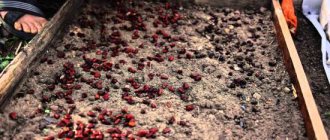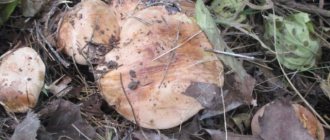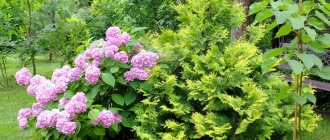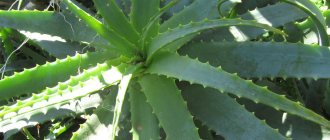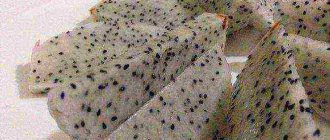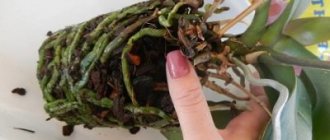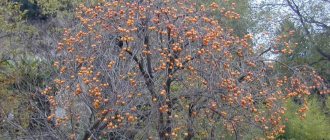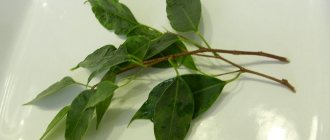Cedar is a beautiful evergreen plant that perfectly purifies the air, and every gardener would not mind planting cedar in their garden. Some people prefer to buy ready-made seedlings, others try to grow cedar themselves from scratch. In this article we will cover in detail the frequently asked question: “How to grow cedar from a nut at home?”
Is it possible to grow cedar from pine nuts?
Inexperienced gardeners often ask similar questions, because they really want to observe the plant from the very beginning of its life and grow cedar completely on its own.
The answer is simple - of course you can! Despite the fact that the process is quite difficult, it is very exciting and it is worth trying to grow cedar yourself.
So that all efforts are not in vain, it is recommended to carefully study the entire growing process: from choosing the seed itself to caring for the growing seedling. Let's look at each of the stages in more detail.
Collecting nuts
All the tree's seeds are contained in cones. You need to start looking for them in the fall or spring among those that have fallen to the ground.
There are several main points to pay attention to:
- Only large nuts can be grown. The likelihood that something will grow from small ones is minimal. In addition, they will be developmentally delayed;
- the color of the nut should be uniform, without any spots and have a brown color;
- Only viable fresh seeds are selected.
Selected nuts are thoroughly washed in hot water (approximately 60 degrees Celsius). This should be done until the water becomes clear. Then the nuts are left in the water for several days, during which time they will swell and sink to the bottom.
High-quality seeds will sink to the bottom, but empty ones will remain floating. They must be removed, because nothing will grow from them.
The washed seeds are left for 3-4 hours in a solution of potassium permanganate.
Planting a seed in a pot
Experts have slightly different opinions about when it is necessary to start sowing seeds in a pot. Some recommend doing this in early March, others – in mid-May.
It is best to listen to the second advice and start doing this in May, so the chance of successful growth increases greatly.
The seeds should be washed and planted in a pot to a depth of 1 centimeter and should be planted with the sharp tip down.
First, place the pot in the shade and store it at room temperature. The plant remains in this position for a couple of months, and after that the first full-fledged shoots begin to appear. As soon as growth begins, the pot should be moved to a sunny place.
Growing cedars
Under natural conditions, cedar seeds that fall from the cones will lie all winter on the cold ground under a layer of snow in order to germinate under the spring sun. This circumstance must be taken into account and the preparation of seeds must be brought closer to natural conditions.
Not many people succeed in germinating pine nuts, since there are certain subtleties in its cultivation. If you follow them, sprouts will definitely appear. We'll talk about how to germinate pine nuts.
You need to start with planting material. Naturally, the best nuts are those that are collected with your own hands, because purchased ones can remain in the warehouse for a long time, and, moreover, be stored incorrectly.
What soil can I plant in?
Few people know, but it can be grown not only in ground soil, but also in sawdust.
If you want to plant cedar in the ground, then you can choose any soil that is suitable for planting conifers. You can buy it in many stores (florists, pet stores, some supermarkets and hypermarkets).
You can prepare the substrate yourself. For this you will need black sand (river and sifted) and peat. These two ingredients must be mixed in a one to one ratio.
The soil can be replaced with regular sawdust. Sawdust can be bought in supermarkets or pet stores.
Landing Features
- Despite the fact that cedar can be grown at home, it is best to keep it in a greenhouse. Light and temperature should be maintained.
- As already mentioned, it is better to plant cedar in the spring. The main thing is that the temperature outside the window is already above zero.
- It is important to pay attention to the pot in which the seedlings are planted. The volume should be approximately 300 milliliters, and its height should be at least 8 centimeters.
- It is worth accepting the fact that cedar germination is a fairly long process. It should grow in a pot for about 4 years until the sprout reaches a size of 18 centimeters.
❀ Disease and pest control
Despite the fact that coniferous trees have disinfectant and antiparasitic properties, they can be attacked by pests and get sick. Young seedlings are especially vulnerable. It is almost impossible to overcome the powerful root system, crown, and strong trunk of a large tree.
Among the pests that attack cedar, it is worth highlighting: pine hermes, pine aphids, common scale insects, pine moths, and pine cone moths.
Diseases and pests of cedar
Pine Hermes came to Europe from North America. This insect is a type of aphid that easily moves through coniferous trees. It is recognized by the white coating that appears on branches and pine needles. This is an accumulation of pest larvae. Hermes feeds on the juices of the plant. As a result, the needles turn yellow. Adult brown insects increase in size and are recognizable even to the naked eye.
This pest is especially dangerous for young trees. He can completely destroy them. Adult affected plants are severely stunted in growth and lose their beautiful appearance.
Ways to fight:
- Remove and burn branches with white coating as soon as it is detected.
- Use chemicals to treat: a) Aktar for watering at the root as a disinfectant: b) fufan, actellik, decis for treating the crown, karbofos, spark, commander for spraying. The regularity of repeating the procedure is once every 3-4 weeks until Hermes is completely eliminated. This must be done to destroy not only the present pests, but also the next generation.
- Treat with environmentally friendly means - infusions of garlic, pepper, soap solution, ash, tobacco. However, they are only effective at the very beginning, with a small insect infestation.
The pine aphid is a gray insect with egg-shaped hair that settles on pine needles. In winter it lays eggs at the bottom of the needles. Every spring they are treated with karbofos. The same spraying is carried out for preventive purposes.
A difficult to exterminate pest is the common scale insect , since it is protected, as it were, by a “shield”. Spring spraying with insecticides helps get rid of it. But it is rarely found on cedars.
The pine moth is a butterfly that settles on a tree at the end of May. She lays eggs on pine needles. In August, caterpillars form from them, eating everything around them. The optimal temperature for their development is 25-27°C.
The fight against caterpillars is carried out at an early stage using the biological product lepidocide or similar means.
The cone moth causes enormous damage to cones, damaging up to 50% of the seeds. Cedar cones fall.
, the bark beetle becomes active . The name itself says that it infects the bark and makes passages in it for the deposition of larvae. They are difficult to notice from the outside. And dead bark with holes is visible to the naked eye. They are fought with the help of special drugs.
Among the pests of cedar there are also Siberian spruce woodcutter and black spruce longhorned beetle.
Seryanka is a dangerous disease for coniferous plants . This fungal disease is also called blister rust or tar cancer. It can last for 20-30 years. During this period, the tree weakens, its growth slows down, and then it dies.
Sick trees and branches must be destroyed.
Helpful advice : do not plant currants and gooseberries near cedar; they act as an intermediate host for the disease.
Rust is a fungal disease. It is placed on the needles in the form of yellow bubbles, which over time turn into powder. Later it spreads throughout the tree. Wet, warm weather is especially favorable for its reproduction.
It is recommended to break off the affected parts and burn them.
Various microorganisms cause mold and rot on cedar seeds. Treatment of seeds and soil, proper agricultural techniques for growing seedlings help prevent fungal diseases.
Helpful advice. Sources of infection are grasses and weeds growing around the cedar. They should be removed regularly.
You can avoid many troubles by carrying out preventive treatment with insecticides.
Growing cedar from seeds is a long process. But as a result, it is possible to improve the area with this majestic plant.
marked
Your opinion is very important to us. Please rate the article: There are no ratings yet. Please rate
See also related articles
How to grow dates from seeds at home in a pot
Tabernemontana: care at home
How to grow pomegranate from seeds at home to produce fruits
Ficus Rubber: pruning and crown formation
How to grow an avocado from a seed at home: in a pot, for beginners
How to grow lemon from a seed at home with fruits: step by step
How to grow chestnut from a nut at home in a pot
How to grow mangoes from seeds at home, in a pot: for beginners
Myrtle tree: care at home
Add a comment Cancel reply
You must be logged in to post a comment.
✿ Alphabetical index
✿ Categories
- Houseplants
- Bromeliads
- Decorative foliage
- Trees and shrubs
- Orchids
- Succulents
- Blooming
- Perennial
✿ Popular articles
- How to grow chestnut from a nut at home in a pot
- Clematis: care and cultivation in the garden
- How to grow pomegranate from seeds at home to produce fruits
- How to grow lemon from a seed at home with fruits: step by step
- Decembrist flower: care at home, how to water correctly
- Hedera "Helix mix": home care
✿ Latest comments
- Lyudmila on How to grow a lemon from a seed at home with fruits: step by step
- Tatyana on Tillandsia Anita: care at home
- LOVE for the entry Tulips: care and cultivation in the garden
Copyright © 2018-2021 GARDENER'S BOOK.
0+ By using bookgardener.ru you accept the terms of the USER AGREEMENT. Copyright for the posted materials belongs to the editors of the online magazine. When reprinting and using materials, an active hyperlink to BookGardener.ru is required
Planting in open ground
It is important to immediately note that the plant does not tolerate transplantation well, which means that it is necessary to immediately select a suitable place for planting the cedar “for growth.” You should retreat more than 10 meters from buildings, and 8 meters from other plants and trees.
The procedure for planting grown seedlings in the ground:
- a hole is dug;
- a third of its size is filled with special nutrient soil. This may not be done, but it will contribute to the rapid development of the root system;
- a seedling is placed in the hole;
- the roots are straightened and the hole is filled with the remaining soil;
- The cedar is watered immediately;
- it is necessary to make a circle in the ground near the trunk, where water will then flow.
How to distinguish cedar from pine
Of course, you can buy ready-made seedlings at the nursery, but they are quite expensive. Considering that this plant is wind pollinated, and to obtain fruits it is necessary to plant several male and female trees nearby, you will have to pay a considerable amount for the purchase of 5-6 seedlings.
In addition, some dishonest sellers may sell ordinary pine instead of cedar to an inexperienced buyer. To distinguish cedar from it, you should carefully examine the needles: in cedar they grow in bunches, 5 pieces in each, and in pine - only 2 pieces.
Pine needles, unlike cedar needles, have different lengths and a darker color. The color of a cedar trunk is gray, and that of a pine trunk is brown.
To avoid fraud, it is better to buy planting material from large nurseries (for example, Sidorkina, Ageeva, Siberian Cedar).
Cedar nursery.
To germinate a cedar seed, you will need to spend a lot of time and effort. But a tree that has been accepted and entered into force will be able to delight others for 500 years.
Planting rules
We have collected several recommendations that can help you avoid mistakes and grow a healthy tree.
- Before finally planting the tree in the ground, it is best to keep the pot of seedlings in the fresh air for a day.
- It is necessary to approximately know the groundwater level - it should be less than three meters.
- You need to carefully dig up a young seedling. It is important not to damage the still fragile root system of the cedar during planting and carefully separate them from the bottom of the pot.
Selecting container and soil
Cedar has a core structure of the root system, so high containers are selected for the seedling. The nuts are immediately sown in separate glasses; the plant does not like picking.
See also Cedar: planting and care in open ground
Plastic pots with a volume of 1-1.5 liters and a height of 25 cm are suitable. You can use trimmed dark-colored plastic bottles.
Expert opinion
Stanislav Pavlovich
Gardener with 17 years of experience and our expert
Ask a Question
Important! It is necessary to make drainage holes in the bottom of the seedling containers to remove excess water. Before filling the pot with earthen mixture, add a handful of gravel or coarse clean sand to the bottom.
The soil for the perennial is prepared loose and breathable. It includes:
- high peat 1 part;
- coarse river sand or vermiculite 1 part;
- land taken at the foot of pines or spruces, 1 part;
- 0.5 parts ground pine litter;
- mature compost or vermicompost 0.5 parts.
To eliminate pathogens from the substrate components, the soil is disinfected by spilling a solution of Fitosporin or potassium permanganate.
Care
As already mentioned, growing cedar is a rather complex process, because the tree requires constant care at all stages of maturation and growth.
Let's look at the features of care at different stages of cedar life, which will help grow a healthy plant.
Seed care
Cedar seeds do not require special care. They just need to be collected and planted in the ground in time. They should look healthy, and if not, they are unlikely to be suitable for planting. The basic procedure for caring for a plant begins at the next stage.
Seedling care
It is important to water the planted cedar on time and not allow the soil to dry out. This is the worst thing that can happen to a seedling at this stage.
It is recommended to spray cedar seedlings daily and avoid overheating or frostbite.
Caring for an adult tree
Care is divided into several stages:
- Watering. When the cedar has already been planted in the ground, it does not need systematic watering. This must be done as the soil dries out. In summer, you can water the tree once every 2 days, in winter once a week or less.
- Feeding. Any fertilizer for coniferous trees is excellent for feeding. Fertilizing is necessary to give the needles an emerald hue.
- Transfer. It is not recommended to replant the tree. But, if necessary, it can be replanted after 2-3 years of growth.
- Trimming. To grow a beautiful cedar, you don't have to trim it. This can be done if the designer or gardener simply wants to give the cedar an unusual appearance.
- Wintering. Cedar is a coniferous tree and can easily withstand winter. The tree should be protected from frost in the first years of its life. To do this, you need to cover the cedar with fabric, and do not forget to water it.
- Pest and disease control. Like other plants, it can get sick. It can be treated with insecticides or fungicidal solutions.
As you can see, it is possible to grow cedar from a nut. If you want to plant a cedar, it is better to do this by purchasing a ready-made seedling. Planting a nut tree is only worth it if you enjoy the process.
Description of types and varieties of cedar
Before growing cedar at home from nuts, its varieties are determined. The most popular Siberian cedar belongs to pine trees and is not related to real cedars.
Atlas cedar
A southern variety of cedar native to the northern parts of Morocco and Algeria. In suitable conditions it grows up to 50 m with a trunk diameter of up to 2 m. It tolerates heat and drought well, and is resistant to frost down to -20 degrees.
The plant is characterized by bluish-green needles collected in bunches. Its peculiarity is the small size of the needles, like those of spruce - the length rarely exceeds 2.5 cm. It has a strong sandalwood aroma. The cones are small, up to 10 cm. Common varieties: Glauka (up to 20 m), Glauka Pendula (weeping, up to 6 m), Fastigata.
Himalayan cedar
An Asian variety of crop common in mountainous regions. The characteristics of the natural habitat conditions determine its ability to tolerate shading. The height of the plant exceeds 50 m, and the diameter of the trunk can reach 3 m. Adult specimens have a pronounced wide-cone-shaped crown with horizontal branches.
The needles are short (up to 5 cm), unusually soft, thin, colored light green with a gray-gray tint. Each bunch contains 30-35 needles.
The duration of ripening of cones is up to 1.5 years, shedding most often occurs in 2-3 years. The cones are located vertically upward on the branches.
Common varieties: Devinely Blue (up to 2.5 m), Silver Mist (up to 1 m), Karl Fuchs, Golden Horizon, etc.
Cedar of Lebanon
The culture grows wild in the mountains of Lebanon, however, due to its resistance to natural conditions, it spreads to other countries. Relatively frost-resistant, tolerates lack of moisture and poor soil. The maximum height of the tree is 50 m, the diameter of the trunk is up to 2.5 m. The crown has a recognizable, wide, umbrella-shaped shape.
The needles are slightly longer than those of the Atlas variety, reaching 3.5 cm. Painted bluish-green, collected in 30 pieces. in bunches. The needles on the plant change every two years. The length of the cone is just over 10 cm.
There are varieties: Nana (about 1 m), Sargenti (up to 1 m), Beacon Hill, Glauka (weeping).
